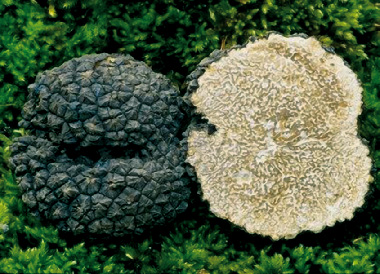Summer Truffle: Red Data Book of Armenia

Category. DD – Data Deficient.
Brief description. Fruit bodies are 2,5–10 cm across, brown, olive– coloured, black, globose or tuberous, fleshy, covered with large pyramidal warts (from 2–10 mm across). Flesh is white, yellowish or greyish, whitish, convolute with marble–like fibrilles, having slight pleasant mushroom smell. Sporosacs (asci) contain 2–8 spores, ellipsoidal and are situated inside the fruit body. Spores are 24–45 x 15–30 µm, ellipsoidal, reticulate.
Distribution. Generally in Europe, Asia, Northern America, Australia, Southern Caucasus (Azerbaijan, Georgia, Armenia). In large quantities it grows in France and Italy, but in Armenia it was found only ones in unique individuals in Ijevan floristic region – in "Dilijan" National Park, in the surroundings of Dilijan city.
Ecological, biological and phytocenological peculiarities. In Armenia it is met in unique individuals, under the soil, in broad–leaved and mixed forests on the altitude of 1400–1800 m above sea level, in September. Mycorrhizal fungi, mainly with oak, hornbeam and beech trees. It is delicious, valuable edible species.
Main factors of endangering. Limited dispersion, loss of habitats, degradation and breakdown of ecosystems, reduction of forest areas caused by uncontrolled felling.
Nature conservation measures. In Armenia it is conserved in corresponding ecosystems of "Dilijan" National Park. It is necessary to carry out monitoring of the state of discovered species and discovery of new habitats.
Suggestions
 The Ministry of Environment sent a letter international partners to draw their attention to the real danger of environmental disasters as a result of Azerbaijan's large-scale aggression towards the territory of Armenia
The Ministry of Environment sent a letter international partners to draw their attention to the real danger of environmental disasters as a result of Azerbaijan's large-scale aggression towards the territory of Armenia
 Vicia pisiformis: Red Data Book of Armenia
Vicia pisiformis: Red Data Book of Armenia
 Vavilovia formosa: Red Data Book of Armenia
Vavilovia formosa: Red Data Book of Armenia
 Trigonella capitata: Red Data Book of Armenia
Trigonella capitata: Red Data Book of Armenia
 Trigonella astroides: Red Data Book of Armenia
Trigonella astroides: Red Data Book of Armenia












